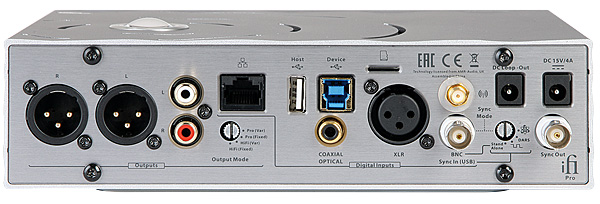iFi Audio Pro iDSD headphone amp/DAC

 The most ambitious iFi digital product to date is a hugely flexible DAC/headphone amp with an eye on both studio and consumer markets. But is it just a bit too complex?
The most ambitious iFi digital product to date is a hugely flexible DAC/headphone amp with an eye on both studio and consumer markets. But is it just a bit too complex?
The idea of the DAC/headphone amplifier is firmly established, whether for ‘on the go’ use, desktop audio or as a main system component. Less than £100 will get you started, with the likes of the AudioQuest DragonFly Black [HFN Oct ’16], Cambridge Audio DacMagic XS V2 or Cyrus SoundKey, while the ambitious might consider models such as the long-running Chord Electronics Hugo [v2, HFN Aug ’18] and costing the thick part of £2000. However, even by the standards of this highly diversified market sector, the range-topping model from iFi Audio, the Pro iDSD, looks pretty punchy with its £2500 price-tag.
Yes, the Pro iDSD does the basics of taking a signal from your computer and outputting it to a pair of headphones, but that’s just the start. There’s a list of settings as long as your arm, but only if you’re an especially long-armed gibbon, and even then there are add-on options if you want to take the unit further.
Slave To The Rhythm
For starters, the Pro iDSD has user-selectable upsampling – all the way to DSD1024 if required – and a choice of valve or solid-state (JFET) output, the option of 6.35mm or 3.5mm headphone outputs or a balanced feed on a 2.5mm socket, adjustable output to suit a wide range of ’phones, and a range of digital filtering options [see Filter Flavours sidebar].
However, the Pro iDSD is rather more than just a DAC/headphone amp, having both standard RCA outputs and XLRs to make the most of its fully-balanced design, and with a choice of fixed or variable output level to enable it to operate as a source component or a digital preamp, plus the option of boosting the gain on the output stage to suit, for example, use in a studio environment. It’s in such a situation that the ability to slave the unit to an external clock, via a multifunction BNC socket on the rear panel, may also be of most use, synchronising every digital component in a chain to a single reference point. Oh, and it’s worth noting that the Pro iDSD has no digital outputs, as these would get in the way of what the unit is all about – digital in, analogue out.

Even that isn’t enough for iFi Audio’s designers, for as well as being able to operate as a conventional DAC, with asynchronous USB 3.0 Type B (rather than the more commonly seen USB 2.0 Type B), for which a cable is provided, AES3 (XLR), combined optical/coax and BNC inputs, the Pro iDSD is also a fully-functioning media player. It has a USB Type A input for memory devices, a microSD slot and – most important – network capability, either via Ethernet or Wi-Fi. Combine it with a smartphone or tablet running the Muzo Player app, more usually associated with the DigiFunk Cobblestone wireless music player, and the Pro iDSD will play music stored on your home network – usually on a NAS unit – as well as accessing services including Spotify, Tidal (with MQA decoding built-in) and Internet radio.
Stack Of Dacs
If you want to stick to just using the unit as a DAC/preamp, there’s also a remote handset, albeit only for volume, while the Pro iDSD draws its power from an offboard supply, and has a loop-through socket to power a second iFi Audio unit.
Using a high-powered XMOS solution for USB and FPGA-based user-selectable upsampling, the digital conversion is based around a stack of four ‘Bit-Perfect’ DSD/DXD DACs from Burr-Brown. Incidentally, all incoming data is reclocked and the digital section can handle content at up to DSD1024 and DXD/PCM 768kHz.
The multifarious digital paths are joined by two analogue output stages. Unlike some DACs with a tube option, which just switch the valves into the signal path for a quick warm-up of the sound, the Pro iDSD has separate valve and solid-state stages that can be selected at will. In addition, there’s a minimal negative feedback ‘Tube+’ setting to increase the ‘valve effect’ [but see PM’s Lab Report].
The valves themselves are a pair of General Electric 5670s, and the company says, ‘For some recordings and headphones/loudspeakers, Solid-State may sound “more lively”. For others, Tube and Tube+ (especially Tube+) will sound more “luxurious”. Select the one that sounds best for that particular moment, be it the recording, the mood or even the weather.’
I’ve never sat in the cockpit of a commercial airliner, but I suspect the pre-flight checks would be only a little more complex than getting the Pro iDSD ready for use, so many adjustments and parameter settings does it offer. I’m all for flexibility of operation, provided it doesn’t impinge on performance, but it took me several attempts to get the right sound out of the desired socket when first using it, and I was grateful for the two ‘white paper’ guides iFi Audio has on its website – one for the front panel, the other for the rear.
Mind you, the instructions for network set-up using the Muzo app were non-existent, but I got there in the end by using the Wi-Fi connection for initial set-up, then rebooting the Pro iDSD to get it into wired connection mode.

























































